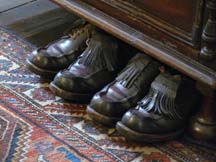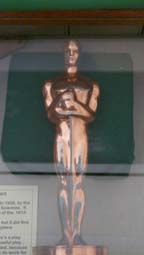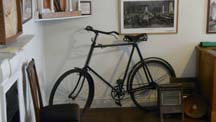Here you can find images of Shaw, his context, and productions of his plays.
You can find more Shaw-related images under Shaw Image Gallery in Content of the Shaw Project.
Shaw’s Corner, managed by the National Trust

- Here you can literally follow Shaw’s footsteps. First, look at Shaw’s shoes, now displayed at Shaw’s Corner. Can you guess the size of these shoes? Can you find any shoelaces? Shaw’s shoes made him very fortunate. He once laced his shoe too tightly, which resulted in an operation on his foot for necrosis. According to Professor Stanley Weintraub, “In the conditions of non-care in which he lived at 29 Fitzroy Square with his mother (the Shaws had moved again on 5 March 1887), an unhealed foot injury required Shaw’s hospitalization. On 1 June 1898, while on crutches and recuperating from surgery for necrosis of the bone, Shaw married his informal nurse, Charlotte Frances Payne-Townshend, at the office of the registrar at 15 Henrietta Street, Covent Garden. He was nearly forty-two; the bride, a wealthy Irishwoman born at Londonderry on 20 January 1857, thus a half-year younger than her husband, resided in some style at 10 Adelphi Terrace, London, overlooking the Embankment.”
1898 also saw the writing of one of Shaw’s most famous works, Caesar and Cleopatra, made into a film in 1945 starring Vivien Leigh, Claude Rains and Stewart Granger directed by Gabriel Pascal. You can watch a trailer of the film here.
Caesar and Cleopatra was nominated for an Oscar which it did not win. But never mind, Shaw has an Oscar for Best Writing, Screenplay from Pygmalion, which is displayed also at Shaw’s Corner.

- Like getting the Nobel Prize, Shaw never went to the award ceremony. Shaw said: “It’s an insult for them to offer me any honour, as if they had never heard of me before – and it’s very likely they never have. They might as well send some honour to George for being King of England”. However, the Oscar statuette did find its way to Shaw’s home, where it became so tarnished that a curator of Shaw’s Corner once used it as a door stop. Here is the statuette, restored to its original glory, displayed at Shaw’s Corner.

- The bicycle found in Shaw
Another item you can find at Shaw’s Corner is a bicycle. Was Shaw a good bicycle rider? Shaw knew Bertrand Russell (1872-1970) through the Webbs since September 1895, when they had a bicycle collision in Monmouth. However, the bicycle also helps Shaw to think. He writes in the Notes to Caesar and Cleopatra: “Again, there is the illusion of “increased command over Nature,” meaning that cotton is cheap and that ten miles of country road on a bicycle have replaced four on foot. But even if man’s increased command over Nature included any increased command over himself (the only sort of command relevant to his evolution into a higher being), the fact remains that it is only by running away from the increased command over Nature to country places where Nature is still in primitive command over Man that he can recover from the effects of the smoke, the stench, the foul air, the overcrowding, the racket, the ugliness, the dirt which the cheap cotton costs us.”

- Have you ever watched Harry Potter? Here is Shaw’s famous revolving writing hut. This writing hut was built on a revolving mechanism that enabled Shaw to follow the sun. Many famous plays, includingPygmalion and Androcles and the Lion, were written in this revolving hut. Just imagine sitting inside this hut without computers, without internet, and without heating or air conditioning, but writing great works.

- Shaw Interior
